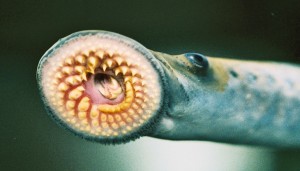
Sea lampreys are using bile salts—secreted by the liver and traditionally used in digestion—as pheromones. The interesting twist is that this scent has evolved as the invasive species’ cologne of choice.
The evolution of bile salts from digestive aid to pheromone, featured in the current issue of the Proceedings of the Royal Society B, mirrors humans’ adaptation of perfume.
It’s similar to how perfume has evolved in our society,” says Tyler Buchinger, one of the lead authors and a doctoral student at Michigan State University. “Perfume was first used to mask body odor due to a societal stigma against daily bathing. Today, in many cases, it exemplifies romance and is used to attract mates.”
Bile salts, like perfumes and colognes, were not first used as sex signals. Their primary use is to process fats. Over many hundreds of years, though, they have evolved to become beacons of sexuality in addition to their digestive duties. The evolution of males emitting this pheromone appears to be a result of female lampreys’ receiver bias, or their desire to mate sparked by the fragrance.
Since time travel is out of the question, Buchinger and Weiming Li, one of the lead authors and professor of fisheries and wildlife, tested the evolution theory on silver lampreys, a species native to Michigan and recognized as a more ancient species than sea lampreys.
The researchers demonstrated that sea lampreys and silver lampreys smell bile salts and acknowledge them as attractants. The difference, however, is sea lampreys become sexually active while silver lampreys do not.
In the field, sea lampreys and silver lampreys were drawn upstream by the smell of bile salts. Only the sea lampreys, though, swam in looking for love and ready to spawn.
Silver lampreys are one of four native lamprey species in Michigan; the others are the chestnut, American brook, and northern brook. Knowing that a distinct scent affects an invasive species differently from the native fauna they are displacing is a research angle worth pursuing, Li says.
“This mating call is quite effective, and it has helped sea lampreys thrive,” he says. “Knowing that bile salts cause sea lampreys to react differently than our native species, which have long been part of our ecosystem, could eventually lead to better ways to control sea lampreys.”
Nick Johnson of the USGS Great Lakes Science Center also contributed to this research.
The Great Lakes Fishery Commission, National Science Foundation, and MSU AgBioResearch partially funded Li’s work.
Source: Michigan State University








